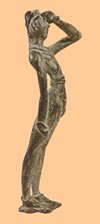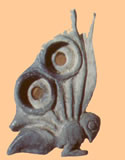 After the National Archaeological Museum in Athens, this is the second largest and second most important museum in Greece. Telephone: 2810 22 60 92. It is located just north of Plateia Eleftherias, on Xanthoudidhou St. and opposite the OTE building. Open 8 a.m. to 7 p.m. Tuesday through Sunday; 12:30-7 p.m. Monday. Admission 4.40 Euros.
After the National Archaeological Museum in Athens, this is the second largest and second most important museum in Greece. Telephone: 2810 22 60 92. It is located just north of Plateia Eleftherias, on Xanthoudidhou St. and opposite the OTE building. Open 8 a.m. to 7 p.m. Tuesday through Sunday; 12:30-7 p.m. Monday. Admission 4.40 Euros.
The most important collection of Minoan art and artifacts is housed in this museum. For those interested in Minoan civilization, it is suggested that you visit this museum first, spending at least half a day in it, before visiting the various Minoan sites, which will greatly increase your appreciation and understanding of the sites. You might want to return afterward as well. To avoid the huge high season crowds, it is also suggested that you come early or late in the day, or at lunchtime. Also-given the immensity of the collection, you should be aware that you may use the same ticket all day long for re-entry, and come and go at your leisure. There are several guides on sale. Highly recommended is the one by J.A. Sakellarakis. (Below left early votive figurine)
 Cretan archaeologists Jos. Chatzidakis and Stephanos Xanthoudides, Ephors of Archaeological Service created this museum during the years 1904-12. In 1937 a new earthquake-proof building was constructed. Though damaged during WWII, the efforts of Prof. Nicolaos Platon ensured the s museum's survival. He arranged exhibitions during the early 50s and a new wing was added to the museum during the 60s.
Cretan archaeologists Jos. Chatzidakis and Stephanos Xanthoudides, Ephors of Archaeological Service created this museum during the years 1904-12. In 1937 a new earthquake-proof building was constructed. Though damaged during WWII, the efforts of Prof. Nicolaos Platon ensured the s museum's survival. He arranged exhibitions during the early 50s and a new wing was added to the museum during the 60s.
 The finds span the six thousand-year period from Neolithic to Roman times (4th cent. A.D.) and include all periods of Cretan history, most important of which are from the Minoan civilization, believed to be first advanced European culture which was inspired in part by Mesopotamian and Egyptian civilizations. It reached its peak on Crete during the period from 1700-1450 B.C. and is divided into three phases (as is Cycladic civilization): 3000-2100 B.C. (Early); 2100-1500 B.C. (Middle); and 1500-1100 B.C. (Late). During the Early period, many elements of Neolithic societies persisted, but after 2500, the Minoan culture (named for the mythical King Minos) emerged as a unique culture. The Middle period represents the climax of Minoan civilization, of which pottery and metalwork on a high level of beauty and skill are manifestations. During the Late period Mycenaeans from the mainland (competing both commercially and militarily) and, around 1100 B.C., Dorian invaders and natural disasters brought it to a finish. During their peaks, both the Minoan and Cycladic civilizations were maritime powers all over the Mediterranean.
The finds span the six thousand-year period from Neolithic to Roman times (4th cent. A.D.) and include all periods of Cretan history, most important of which are from the Minoan civilization, believed to be first advanced European culture which was inspired in part by Mesopotamian and Egyptian civilizations. It reached its peak on Crete during the period from 1700-1450 B.C. and is divided into three phases (as is Cycladic civilization): 3000-2100 B.C. (Early); 2100-1500 B.C. (Middle); and 1500-1100 B.C. (Late). During the Early period, many elements of Neolithic societies persisted, but after 2500, the Minoan culture (named for the mythical King Minos) emerged as a unique culture. The Middle period represents the climax of Minoan civilization, of which pottery and metalwork on a high level of beauty and skill are manifestations. During the Late period Mycenaeans from the mainland (competing both commercially and militarily) and, around 1100 B.C., Dorian invaders and natural disasters brought it to a finish. During their peaks, both the Minoan and Cycladic civilizations were maritime powers all over the Mediterranean.
Much scholarly attention has been focused on the literacy of the Minoans, with their first script resembling Egyptian hieroglyphs and their later one (known as Linear A) based on syllables. It is believed that these scripts, engraved on clay tablets, had to do with domestic accounting (contents of storerooms, etc.) and trade transactions.
 Seismic events also played a large role in the downfall of the 900-year Minoan civilization with destruction of the palaces at Knossos, Phaestos, Malia and Zakros by a massive earthquake in 1700 B.C. and the later volcanic explosion that blew out the entire center of the island of Thera (later known as Santorini) around 1500 B.C., is said to have caused massive tsumami-like tidal waves and horrific fallout of volcanic ash which may have caused crop failures. Inbetween destructions, palaces were rebuilt, and made larger and more luxurious with advanced drainage systems, royal apartments, apartments for staff, storerooms and workshops, reception halls. Beautiful frescoes adorned the walls, which have been pieced together from fragments and which occupy the second storey of the Herakleion museum.
Seismic events also played a large role in the downfall of the 900-year Minoan civilization with destruction of the palaces at Knossos, Phaestos, Malia and Zakros by a massive earthquake in 1700 B.C. and the later volcanic explosion that blew out the entire center of the island of Thera (later known as Santorini) around 1500 B.C., is said to have caused massive tsumami-like tidal waves and horrific fallout of volcanic ash which may have caused crop failures. Inbetween destructions, palaces were rebuilt, and made larger and more luxurious with advanced drainage systems, royal apartments, apartments for staff, storerooms and workshops, reception halls. Beautiful frescoes adorned the walls, which have been pieced together from fragments and which occupy the second storey of the Herakleion museum.
The twenty exhibit halls of the Herakleion Archaeological Museum house artifacts arranged both chronologically and geographically (ie. according to where items were found--palaces, graves, villas, etc. Jewelry, metalwork, furniture, weapons, tools, sculpture, ceramics, masonry, household items, idols, sarcophagi, and frescoes are represented, mostly from Knossos and Ayia Triada. The latter demonstrate the Minoans' love of movement and games, and of nature.